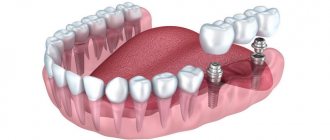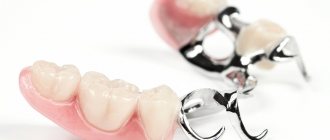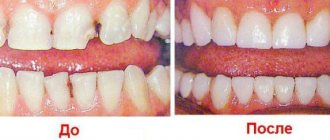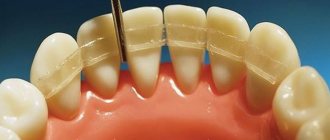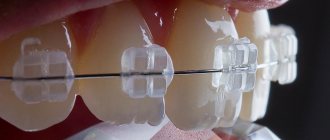Classification by curing mechanism
- chemically cured composites;
- hot curing (the polymerization reaction is initiated under the influence of high temperatures);
- cold curing (the reaction is initiated by a redox mechanism at room temperature);
- light curing.
Light-curing composites vary in paste consistency. They are divided into dense, or packable, as well as varieties of fluid or universal (medium) consistency.
Silorans
Siloranes are representatives of a new era of substances in dentistry. Siloranes also contain substances used in the chemical industry. However, this material is distinguished by its good biocompatibility, low shrinkage, and wear resistance. Silorans have a convenient working time, which reaches up to 9 minutes in the presence of general lighting.
Siloranes are used to restore Black class 1–2. There are some nuances in working with silorans. The first is the need to install a gasket; the second is its incompatibility with adhesive systems of compomers and flowable composites. However, silorans are pleasant to work with: they do not stick to the tool, pack well and are polished.
At this point in time, unfortunately, there are no long-term clinical results with the use of silorans, but the prospects for this group of materials are not bad!
Disadvantages of composites
The main disadvantage of composite materials is polymerization shrinkage, as a result of which the dimensions and concentration of internal stresses change. In addition, some of them have insufficient wear and color fastness.
High-viscosity (dense) composites have increased compressive strength and greater rigidity than other composites. They are characterized by less shrinkage, and changes in size with temperature fluctuations are practically no different from those of natural dental tissues.
Composites with a flowable consistency have improved aesthetic properties, but are less durable and exhibit increased shrinkage during curing. Their coefficient of thermal expansion is also worse than that of teeth.
Composites on posterior teeth are subject to rapid wear at contact points where the loads are highest. On the chewing teeth, a violation of the marginal seal is also observed. Therefore, it is recommended to use dense varieties with higher wear resistance.
Flowable composites: advantages and application features
Flowable composites have a more liquid structure compared to traditional ones. This allows them to penetrate small defects. Fissures qualitatively fill the problem areas of the area affected by caries. The term “liquid composites” is also often used.
Today, flowable composites are produced by almost all manufacturers of dental materials. They are often marketed as a “smart replacement” for dentin. They have fairly large particles, and most of them use microhybrid filler. Also recently you can find composites based on nanofillers.
Liquid-flowing composite has a number of advantages, due to which it is widely used both for the preparation of caries and for the aesthetic restoration of teeth:
- High elasticity. This makes it possible to compensate for the stress that occurs at the interface of the tooth tissue and the filling material during polymerization shrinkage and chewing loads.
- Good fluidity. Thanks to this, materials are easily introduced into the caries cavity, including hard-to-reach areas. They can be used on vertical surfaces.
- Good shape retention. After the pressure stops, the materials retain their shape perfectly. They do not drain from surfaces and are evenly distributed along the walls of the carious cavity.
Some composites are used to seal fissures, so they have increased fluidity. In addition, almost all modern materials have high radiopacity, which makes it possible to dynamically monitor the condition of the filling and the tissues adjacent to it using x-rays.
There are a couple of downsides to note. Thus, in terms of strength, liquid composites are not as strong as microhybrid and nanofilled ones. Therefore, they are applied in a thin layer and are often used together with more durable materials. Also, the disadvantages include significant polymerization sediment, but this does not lead to significant problems due to elasticity.
To increase the strength characteristics of composites, the particle size of their filling increases. Because of this, these materials are inferior to their analogues in terms of aesthetics, but the use of nanotechnology has been able to eliminate this drawback. Thanks to special processing, nanofilled composites have good durability and polishability compared to conventional ones, which expands the possibilities of their use.
Contraindications
Composite materials are contraindicated if the patient has toxic or allergic reactions to polymers, as well as with bruxism and parafunction. Relative contraindications include increased abrasion of antagonist teeth, as well as the presence in the oral cavity of antagonist teeth covered with crowns made of noble alloys.
Composite materials are an ideal solution for restoring anterior teeth when aesthetics are a priority rather than strength requirements due to the low chewing load. They retain the original shade, have good adhesion and a low rate of recurrent dental damage. An important nuance is that over time they lose their initial relief, since they are constantly exposed to abrasive wear during chewing, brushing teeth and exposure to the erosive environment in the oral cavity.
Bandages
Artificial dentin (aqueous dentin) - zinc oxide (66%) + zinc sulfate (24%) + kaolin (10%).
Mixed with water. (Aqueous dentin, oxidentin, timodentin) Dentin paste - artificial dentin powder + a mixture of two vegetable oils (clove and peach). Available in ready-made form (“Dentin paste”, “TempBond”, “Zinoment”).
Eugenol-free dentin pastes (eugenol is replaced by polymethyl methacrylate). The packaging is usually labeled “NE” (nonevgenol) or “Eugenolfree”. (Cimavit, Coltosol, Simpat, TempBond NE, Tempit, Tempopro, Tempolat).
Photocurable temporary dressings (Clip, PrevisionFill, Fermit, Tempit L/C).
Zinc oxide eugenol cements – zinc oxide + eugenol or clove oil
Requirements for materials for medical pads
Therapeutic pads should:
— have an anti-inflammatory and reparative effect on the pulp;
- have bacteriostatic and bactericidal effects;
— have good adhesion to hard dental tissues;
- be plastic;
- withstand pressure after hardening;
- do not irritate the tooth pulp.
Classification of composites in dentistry
Composites used in dentistry are multiphase compositions. They vary in degree of viscosity. The main functions performed by composites or photocomposites in dentistry are therapeutic and aesthetic. They gained popularity due to their plasticity, which is combined with strength.
The classification of these dental products is large and complex. This is due to the variety of dental composites available. They differ in the components in the composition, in the size of the filler, in function and other indicators. For example, different types of teeth will be used depending on their function. There are composites that are intended for the treatment of front teeth and lateral teeth necessary for chewing food. There are formulations that are suitable for all teeth.
Composite material consize
Recently, the recently developed new composite filling material consize has become popular. It has high aesthetics, good adhesion to fabrics and other materials.
But considering that with such a filling, the tooth enamel is treated with acid, it is imperative to apply an insulating gasket. The advantage of using this material is the absence of preliminary preparation.
Installation method
The surface is thoroughly cleaned using mechanical treatment. The etching liquid is applied for 1.5-2 minutes, after which the tooth
washed with clean water and dried thoroughly.
After this process, it is necessary to ensure that the tooth is isolated from saliva. The etched area will take on a pretty color. Then use a swab to mix two equal parts of liquid filling material and apply it to the area.
After this, mix two parts of the previously prepared paste and fill the cavity. When modeling, use a smoothing iron, and in case of significant defects, use a cellophane cap.
The excess should be eliminated before the conseise hardens. Hardening of the filling takes up to 8 minutes, after which you can begin mechanical processing. All materials, including paper towel and foam swabs, are included in the kit.
The article discusses modern filling materials most commonly used in dentistry. Before starting work, it is necessary to carefully determine the degree of the patient’s disease and dental defect.
Filling material Estelite
Since manufacturers use components with different consistencies in the manufacture of materials, it is necessary to read the instructions before starting filling. The hardening and thickening time of the mixture may vary slightly. But at the slightest deviation from the required conditions, the filling may lose the required properties.
